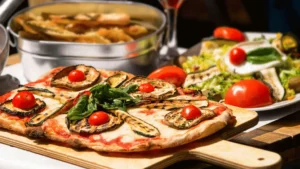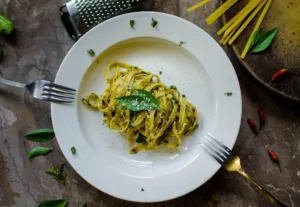Italian cuisine, with its rich flavors and diverse dishes, pairs beautifully with a variety of wines. From robust reds to crisp whites, the right wine can elevate an Italian meal to a sublime dining experience. Let’s explore the best wine for Italian food, considering regions, flavors, and the art of pairing.
The Harmony of Italian Wine and Food
Understanding the Basics of Pairing
The key to a successful pairing is balance. The wine should complement the flavors of the food, neither overpowering it nor being overshadowed. Italian wines, with their inherent acidity and tannin structure, are particularly well-suited for pairing with the country’s cuisine.
Regional Pairings: A Local Approach
Italy’s wines and foods have evolved together, so regional pairings are a great starting point. For instance, a Chianti or Sangiovese from Tuscany pairs perfectly with dishes featuring tomatoes and herbs, typical of the region.
Red Wines: A Bold Companion for Italian Dishes
Chianti and Sangiovese: The Heart of Italian Red Wine
Chianti is the most popular wine to pair with Italian food. It’s made primarily from Sangiovese grapes making it an quintessential Italian red. Its high acidity and notes of cherry and earth complement tomato-based pasta sauces, pizza, and meats.
Barolo and Brunello: The Kings of Italian Reds
Barolo and Brunello, made from Nebbiolo and Sangiovese grapes respectively, are rich in flavor and complexity. These wines, with their deep notes of blackberry and spices, are ideal for hearty dishes like lamb and risottos with mushrooms.
Montepulciano and Barbera: Versatile and Flavorful
Montepulciano offers a more approachable, fruit-forward profile. Its versatility makes it suitable for a wide range of dishes, from pasta to chicken. Barbera, with its bright acidity and notes of dark fruit, is excellent with meat dishes and rich sauces.
White Wines: A Refreshing Contrast to Italian Cuisine
Pinot Grigio and Gavi: Light and Crisp
Pinot Grigio, known for its lightness and crisp acidity, is an excellent choice for seafood dishes, especially those with clams or scallops. Gavi, with its subtle notes of apple and pear, complements lighter pasta dishes and risottos.
Vermentino and Soave: Unique and Aromatic
Vermentino, with its floral and citrus notes, pairs well with herbs and lighter sauces. Soave, another delightful white, offers a combination of fruitiness and minerality that works well with chicken and pasta dishes.
Chardonnay and Sauvignon Blanc: The International Touch
While not traditionally Italian, Chardonnay and Sauvignon Blanc have found a place in Italian cuisine. Chardonnay, with its richness and buttery notes, pairs well with creamy sauces, while Sauvignon Blanc’s zesty acidity complements dishes with basil and other fresh herbs.
Sparkling and Sweet Wines: Adding a Festive Touch
Prosecco and Lambrusco: Bubbles and Joy
Prosecco, Italy’s famous sparkling wine, is a fantastic choice for any celebration and pairs wonderfully with appetizers and light dishes. Lambrusco, a slightly sparkling red, offers a sweet and tangy experience, perfect for cutting through the richness of cheeses and cured meats.
Amarone and Super Tuscan: The Bold Flavors
Amarone, known for its robust body and raisin-like sweetness, can be a great partner for rich, savory dishes. Super Tuscans, a blend of traditional and international grapes, offer a modern twist to pair with a variety of Italian dishes.

Tips for Choosing the Right Wine for Italian Food
Consider the Sauce and Spices
The sauce is often the defining element of an Italian dish. Lighter, white sauces pair well with white wines like Pinot Grigio or Chardonnay, while red sauces go hand-in-hand with Chianti or Montepulciano.
Texture and Richness
The texture and richness of a dish should match the wine. Heavier, richer dishes call for full-bodied wines like Barolo or Amarone, while lighter dishes pair better with lighter wines like Vermentino or Pinot Grigio.
Experiment with Local Varieties
Italy offers a wide variety of lesser-known local wines that can provide a unique pairing experience. Don’t hesitate to try a new regional wine with your Italian meal.
The Ultimate Italian Dining Experience
Pairing Italian food with the right wine is not just about taste; it’s about creating an experience. Each glass of wine and every dish tells a story of a region, its traditions, and its people. By understanding the characteristics of Italian wines and the essence of its cuisine, you can create unforgettable food and wine pairings.
Delving Deeper into Pairings for Specific Italian Dishes
Pasta Dishes: A Staple of Italian Cuisine
Pasta, a cornerstone of Italian cuisine, offers a diverse canvas for wine pairing. For instance, a robust Cabernet Sauvignon complements a rich Bolognese sauce, while a delicate Pinot Grigio is a perfect match for a seafood linguine.
Each type of pasta, depending on its sauce and ingredients, calls for a different wine to enhance its flavors.
Pizza: Italy’s Iconic Fast Food
The variety of toppings on pizzas means there’s a range of wines to match. A classic Margherita pizza goes beautifully with a light Sangiovese, while a meat-laden pizza might pair better with a bolder Amarone or a Super Tuscan.
The acidity in these red wines balances the richness of the cheese and the tang of the tomato sauce.
Seafood: The Essence of Coastal Italian Cooking
Italian seafood dishes range from simple grilled fish to elaborate seafood pastas and risottos. Crisp white wines like Vermentino or Gavi are ideal for lighter seafood dishes. For richer preparations, like a seafood risotto, a fuller-bodied white such as Chardonnay can be a great choice.
Meat Dishes: From Lamb to Beef
Italian cuisine features a variety of meat dishes, each requiring a specific wine pairing. Lamb dishes, often seasoned with rosemary and garlic, pair wonderfully with a robust Barolo. Beef dishes, such as the classic Osso Buco, call for a rich, complex wine like Brunello di Montalcino.
Vegetarian Italian Dishes
For vegetarian dishes, which often feature herbs, tomatoes, and cheese, a medium-bodied Barbera or a zesty Sauvignon Blanc can enhance the flavors without overpowering the dish.
Exploring Italian Wine Regions and Their Signature Wines
Tuscany: The Land of Sangiovese
Tuscany is synonymous with Sangiovese, the grape behind Chianti and Brunello di Montalcino. These wines, with their notes of cherry, plum, and earthy spices, are versatile partners for a wide range of Italian dishes.
Piedmont: Home of Barolo and Barbera
Piedmont is known for its Barolo and Barbera wines. The Nebbiolo grape, used in Barolo, produces wines that are powerful yet elegant, ideal for pairing with rich meat dishes and aged cheeses.
Veneto: The Birthplace of Amarone
Veneto is famous for Amarone, a rich and potent wine made from partially dried grapes. Its deep flavors of dark fruit, chocolate, and spices make it an excellent choice for hearty stews and aged cheeses.
Sicily and Sardinia: Islands of Unique Flavors
Sicilian and Sardinian wines, such as Nero d’Avola and Vermentino, offer unique flavors that reflect the islands’ distinct terroirs. These wines are great with seafood and dishes featuring bold spices and herbs.
Wine Pairing Tips for an Authentic Italian Dining Experience
Consider the Regionality
When in doubt, a safe bet is to pair a dish with a wine from the same region. Regional food and wine have evolved together and often create harmonious pairings.
Texture and Flavor Profile Matching
Matching the texture and flavor profile of the wine to the dish can lead to a delightful pairing. Rich, complex dishes go well with full-bodied wines, while lighter dishes pair better with lighter wines.
Don’t Forget the Cheese
Italian cuisine features a variety of cheeses, each with its own distinct flavor and texture. Aged cheeses like Parmigiano-Reggiano pair well with bold reds, while softer cheeses like mozzarella are best with lighter reds or crisp whites.
The Role of Wine in Italian Dining Culture
Wine as an Enhancer of Food
In Italian culture, wine is not just a beverage; it’s an integral part of the dining experience. It’s seen as an enhancer of food, a component that brings out the best in each dish.
The Social Aspect of Wine Drinking
Sharing a bottle of wine is a social experience, a way to bring people together. In Italy, wine is often enjoyed in a communal setting, reflecting the country’s emphasis on family and community.
Conclusion: The Joy of Italian Wine and Food Pairing
Pairing wine for Italian food is an art form, one that enhances the dining experience and brings joy to the table. Whether it’s a simple pasta dish or an elaborate multi-course meal, the right wine can elevate the flavors and create a memorable culinary journey. Hungry? Find the best Italian restaurants near you here.







